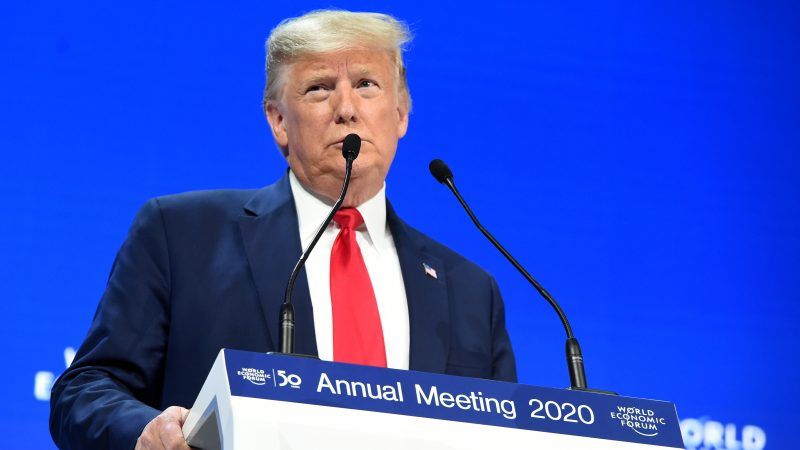Trump's Labor Department Provides Clarity on Joint Employment
Good news on the economic front.

Three years into the Trump administration, we see a clear pattern forming. The Obama administration implemented labor rules that make the labor market less flexible, often at the expense of smaller businesses, but in ways that made unions happy. The Trump administration then takes these rules away. The latest example is the dismantling of the Obama Labor Department's joint employer rule.
As the new Secretary of Labor Eugene Scalia and the Office of Management Director Mick Mulvaney explained recently in The Wall Street Journal, "When joint employment exists, two separate companies are responsible for ensuring that workers receive the federally mandated minimum wage and overtime pay. Two companies are responsible for ensuring the proper records are kept. And two companies can be taken to court if it's alleged that those responsibilities have not been met."
The question is: When is there actually joint employment? From 1958 to 2015, joint employment was said to exist when two employers are "not completely disassociated" from each other. This needlessly vague phrasing was only worsened by the Obama administration's attempted clarification. A 2015 ruling by the National Labor Relations Board, followed by a 2016 legal interpretation adopted by the Labor Department, expanded joint employment to any business with "indirect influence" over another company's employment terms and conditions.
That was a big deal for a wide range of franchise, subcontract, and supplier business models. These diverse business forms were forced into a one-size-fits-all model of "joint employment," thus opening them up to legal troubles caused by their contractors and franchisees. For instance, under this rule, Subway—the biggest franchise by far in the United States in terms of number of stores at 23,647—can be sued for the lack of labor compliance at any of its independently owned stores across the country. Even if you have little sympathy for big business, think about all the self-employed contractors and subcontractors affected by the rules.
As Walter Olson of the Cato Institute wrote at the time, "What do advocates of these changes intend to accomplish by destroying the economics of business relationships under which millions of Americans are presently employed? For many, the aim is to force much more of the economy into the mold of large-payroll, unionized employers, a system for which the 1950s are often (wrongly) idealized."
This classification is also very costly. A study by economist Ronald Bird for the Chamber of Commerce concluded that the expanded rule costs businesses between $17.2 billion and $33.3 billion a year—mostly to protect themselves against legal actions rather than on tighter labor compliance.
Bird also documented how the Obama rule forced many national brands to distance themselves from their franchisees out of fear of being sued and shifted many training and software responsibilities to the franchisees. Unfortunately, franchisees, which are smaller businesses, are often not as well equipped to handle such responsibilities or do so at costs as low as those achieved by larger companies. Thus, their total cost of doing business rises. Despite franchisee efforts to shield themselves from abusive legal actions, there has been a 93 percent increase in lawsuits against franchise businesses since the rules made such lawsuits more lucrative.
Enter the Trump administration and its new rule, which specifies that a company cannot be considered a joint employer simply because it has the contractual power to control workers employed by another party. Instead, there has to be "some actual exercise of control." This is good news because stable and predictable rules, compared to unstable and vague ones, are clearly more conducive to all aspects of life, including the franchise business.
Not surprisingly, after spending millions of dollars fighting for the Obama-era rules, unions are upset by this recent change. The Obama rule had opened up deeper pockets for lawsuits to pick and, more importantly from a financial standpoint, opened the unions up to many more potential members.
But for now, we celebrate. As Olson recently wrote on the Trump rule, "This is an important win for economic freedom, as well as for the legal reality that a supply or contractual relationship between two firms is by no means the same thing as a merger between them."
COPYRIGHT 2020 CREATORS.COM
Editor's Note: As of February 29, 2024, commenting privileges on reason.com posts are limited to Reason Plus subscribers. Past commenters are grandfathered in for a temporary period. Subscribe here to preserve your ability to comment. Your Reason Plus subscription also gives you an ad-free version of reason.com, along with full access to the digital edition and archives of Reason magazine. We request that comments be civil and on-topic. We do not moderate or assume any responsibility for comments, which are owned by the readers who post them. Comments do not represent the views of reason.com or Reason Foundation. We reserve the right to delete any comment and ban commenters for any reason at any time. Comments may only be edited within 5 minutes of posting. Report abuses.
Please to post comments




I prefer to employ a bong. Hahaha I'm so funny! Oh God...woooo
Trey's not here, man.
Trump Trump everywhere. counting days.
I do agree!
But I also want to be fair... Here's at least ONE thing that the Trump Admin has done that is good (helpful). Fuck the endless armies of unions and their scum-sucking lawyers! All that they do for me, is to drive up my costs!
I believe by your own past you now have to call yourself a trump worshipping trumpista. Because one agreement is literally your level for laying that moniker on someone.
You may not know what the word "literally" means.
Well Done..
He is doing great
It's about time someone exercised some common sense in Washington DC.
"Good news on the economic front"?
As Palin's Buttplug repeatedly explained, Drumpf has been terrible for the economy. Any good news should still be credited to Obama, who oversaw the strongest 8-year run in US economic history.
#PleaseComeBackButtplug
Chamber of Commerce concluded that the expanded rule costs businesses between $17.2 billion and $33.3 billion a year—mostly to protect themselves against legal actions rather than on tighter labor compliance.
It seems that a good majority of the busy-body politicians are lawyers. Making work for fellow lawyers is a feature of busy-bodyism not a bug.
Best President in US History.
Thanks to Democrats, it's mainly from rolling back their rules along with surviving a coup and joke Impeachment.
Personally, I think that rules defining when a "joint employment" relationship exists should be based upon a sound analysis of the arrangement in question, rather than picking and choosing factors in order to achieve a predetermined policy goal.
Weird, I know.
It's odd to me, too, that the term "economic freedom" is used to describe protection from lawsuits for violating labor and employment law.
Are workers' rights not relevant? How are we winning "economic freedom" if the result of this rulemaking is that workers will have a harder time negotiating the terms of their employment or forcing their employers to comply with the law?
Well, since this rulemaking won't make anything harder for workers to negotiate with their actual employers, my guess is that you didn't really read the article.
"Joint employment" was a fiction that had nothing to do with protecting workers. It's sole purpose was to allow lawsuits to reach the deep pockets of people who had little or nothing to do with the infractions of the actual employer.
I am not sure I would go so far as to call it an entire "fiction." Consider an arrangement like this: John Doe works for Acme Inc. Acme then agrees that Doe will teach classes related to their specialty at Local-third-tier-toilet University(LTTTU). LTTTU has control over the number of classes, the class schedule, curriculum, and what duties Doe must perform in the course of providing services to LTTTU. Is it not fair to say that Doe effectively works for both of them? If he does not work for both, who does he work for? Who is on the hook for overtime violations? Pension payments?
It seems reasonable to me (and probably would work under the Trump clarification) to make Acme and LTTTU jointly liable as joint employers if their arrangement violates Doe's rights in some way, as it is not altogether clear either one has sufficient control in the situation to unilaterally remedy any problems and I would bet a ridiculous sum of money that both will try to shift the blame to the other.